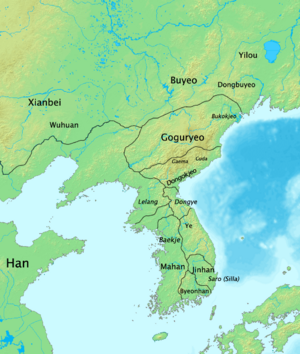Proto–Three Kingdoms period facts for kids
| Proto–Three Kingdoms period | |
 |
|
Quick facts for kids Korean name |
|
|---|---|
| Hangul | |
| Hanja | |
| Revised Romanization | Wonsamguk Sidae |
| McCune–Reischauer | Wŏnsamguk Sidae |
The Proto–Three Kingdoms period (or Samhan period) was an important time in Korean history. It happened after the ancient kingdom of Gojoseon fell. This period was also before the famous kingdoms of Goguryeo, Baekje, and Silla became very powerful. It covers the first three centuries of the Common Era, from around 1 AD to 300 AD. This time is often seen as the early part of Korea's Three Kingdoms period.
History of Early Korean States
After Gojoseon was defeated by China's Han dynasty in 108 BC, new states appeared. In the northern part of the Korean Peninsula and Manchuria, states like Buyeo, Goguryeo, Okjeo, and Dongye grew stronger.
The kingdom of Goguryeo is traditionally said to have started in 37 BC. However, Chinese records mention it even earlier, around 75 BC. China tried to control parts of the old Gojoseon land by setting up four special areas called commanderies. But Korean groups quickly fought back, and three of these Chinese areas soon fell. Goguryeo slowly grew by taking over its neighbors. It finally destroyed the last Chinese commandery in 313 AD.
In the southern part of the peninsula, a state called Jin existed. From Jin, three groups of smaller states formed: Jinhan, Byeonhan, and Mahan. These three groups are together known as the Samhan.
Baekje was founded in 18 BC in the Mahan area. It slowly began to take control of Mahan. Silla was formed by joining six smaller groups within Jinhan. This happened traditionally in 57 BC, though it might have been a bit later. Byeonhan later joined with the Gaya confederacy. Eventually, Silla took over Gaya.
Because these kingdoms grew from earlier states, many historians believe the Three Kingdoms period began around the fall of Gojoseon. However, Goguryeo, Baekje, and Silla didn't fully control the peninsula as powerful kingdoms until about 300 AD.
The Rise of Iron Culture
During this period, iron became very important. People started making many iron tools and weapons for daily use. They also began using a new type of grey pottery with a special pattern.
Archaeologists have found many items from this time. These finds are mainly from areas like Nakrang and Goguryeo in the north. In the south, many items come from the Samhan region. People used both bronze and iron. Iron was even made at sites along the southern coast where ancient shell piles are found.
Archaeological sites in this region show a mix of cultures. Items from the Korean Bronze Dagger culture are found alongside Chinese and Northern Steppe artifacts. This shows that the early Korean kingdoms traded and interacted a lot with Han China and other areas.
The new iron technology was a big step forward. It allowed people to make stronger and sharper weapons and farm tools. This led to faster political changes. It also helped leaders gather more power and wealth.
Trade and Connections
Records from the "Annals of the Three Kingdoms" in China tell us about trade during this time. They mention that iron from the Nakdong River basin in Korea was sent to Lolang (a Chinese area in Korea) and to Wae (ancient Japan). This shows that there was a lot of contact with cultures in China and Japan.
Archaeological evidence also proves these connections. In the southern Korean Peninsula, Chinese bronze mirrors, special bronze ritual vessels, bronze buckles, and Chinese coins have been found. These items were discovered in ancient shell piles and tombs.
Objects from the Northern Province (like Manchuria) have also been found. These include bronze 'Fu' vessels, and buckles shaped like tigers and horses. From Wae (Japan), archaeologists have found Yayoi pottery, jar coffins, and wide bronze spearheads and halberds. These finds show a busy network of trade and cultural exchange.
See also
- History of Korea
- Four Commanderies of Han
- National Treasure of South Korea
- Three Kingdoms of Korea

